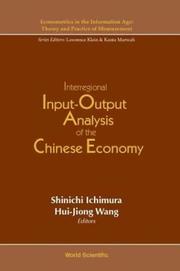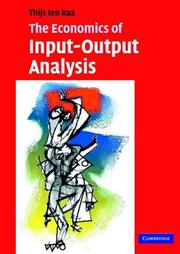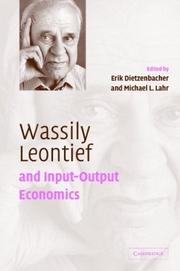| Listing 1 - 10 of 10 |
Sort by
|
Book
ISBN: 148758606X 9781487586065 9781487587055 1487586485 1487587058 Year: 1967 Publisher: Toronto : University of Toronto Press,
Abstract | Keywords | Export | Availability | Bookmark
 Loading...
Loading...Choose an application
- Reference Manager
- EndNote
- RefWorks (Direct export to RefWorks)
This timely study fills some serious gaps in the historical record of economic development in Canada and compares it with that in the United States pointing out the parallels in development that have resulted from similarities in tastes and technologies and the high degree of monility between two economies. In addition, it clarifies certain mistaken notions about the Canadian economy by evaluating the sources of past growth and anticipating the potential open to the country. This edition includes a chapter which examines Canadian experience over the past decade and compares it with that of the United States. This work will be valuable to economists, policy makers and the informed layman. There is a minimal amount of complex mathematics and the bulk of the statistical material is relegated to the apendices.
Canada --- Economic conditions --- Input-output analysis --- Interindustry economics --- Economics, Mathematical --- National income --- Input-output tables --- Accounting --- E-books

ISBN: 9812385568 9786611935504 1281935506 9812795057 9789812795052 9789812385567 9781281935502 6611935509 Year: 2003 Publisher: Singapore : World Scientific Pub. Co. Pte Ltd.,
Abstract | Keywords | Export | Availability | Bookmark
 Loading...
Loading...Choose an application
- Reference Manager
- EndNote
- RefWorks (Direct export to RefWorks)
This book presents pioneering work on an interregional input-output table of the Chinese economy and its applications to the analysis of interregional and interindustrial relations in China. It is the fruit of the authors' joint efforts of more than five years to establish a solid basis for the analysis of interregional relations in China, in the hope of laying the foundation for further studies of regional development in that country. The book endeavors to make a contribution to the regional typology of the Chinese economy. The Chinese provinces are classified into seven large regions. The
Input-output analysis -- China. --- Input-output tables -- China. --- S10/0251 --- China: Economics, industry and commerce--General works and economic history: since 1989 --- Input-output analysis --- Input-output tables --- Interindustry economics --- Economics, Mathematical --- National income --- Accounting
Book
ISBN: 1280817062 9786610817061 0387352317 Year: 2007 Publisher: New York : Springer,
Abstract | Keywords | Export | Availability | Bookmark
 Loading...
Loading...Choose an application
- Reference Manager
- EndNote
- RefWorks (Direct export to RefWorks)
Providing a systematic and comprehensive treatment of recent developments in efficiency analysis, this readable book makes available an intuitive yet rigorous presentation of advanced nonparametric and robust methods. This flexible toolbox can be used in theories based on the neoclassical theory of production and its alternatives, including evolutionary theories. The methods are complemented by empirical analysis of three different economic fields: scientific research, mutual funds industry and the insurance sector. The research demonstrates the utility of the toolbox for a wide range of economic issues, including the analysis of economies of scale and scope, dynamics of age and agglomeration effects, trade-offs in production and service activities, and explanations of efficiency differentials. Of interest to applied economists broadly, this book will also be of interest to those focused on Operations Research and/or Management Science. "Léopold Simar is a pioneer. For over a decade he and a succession of talented co-authors have been addressing the shortcomings of the increasingly popular field of nonparametric frontier analysis for producer performance evaluation. The shortcomings of nonparametric frontier models include their deterministic and non-statistical nature, their sensitivity to outliers and extreme values, the absence of parameters that would enhance economic interpretation, and the lack of suitable techniques for incorporating exogenous influences on performance. This book, written with Cinzia Daraio, develops theoretical and empirical techniques for dealing with each. The problems are difficult and the analysis is advanced, but Simar and Daraio have delivered on their claim to have written a book that is both rigorous and readable. This original contribution will change the field." -C. A. Knox Lovell Léopold Simar is an established star in the productivity/efficiency field. He is like a fine vintage wine – a pleasure to drink today. Cinzia Daraio is a rising star. She is like a new wine from an established vineyard – excellent today, even better tomorrow. Cinzia and Leopold combine forces in this book. The result is a treat to drink, worthy of a feast. It is a sumptuous presentation of new research that embeds the nonparametric approach to efficiency measurement into a statistical framework. Enjoy" -Harold O. Fried.
Industrial efficiency. --- Input-output analysis. --- Industries. --- Production functions (Economic theory) --- Functions, Production (Economic theory) --- Production (Economic theory) --- Economics --- Industrial production --- Industry --- Interindustry economics --- Economics, Mathematical --- National income --- Input-output tables --- Efficiency, Industrial --- Industrial management --- Mathematical models --- Accounting --- Operations research. --- Management. --- Operations Research/Decision Theory. --- Administration --- Industrial relations --- Organization --- Operational analysis --- Operational research --- Industrial engineering --- Management science --- Research --- System theory
Periodical
ISSN: 09535314 14695758 Publisher: Abingdon
Abstract | Keywords | Export | Availability | Bookmark
 Loading...
Loading...Choose an application
- Reference Manager
- EndNote
- RefWorks (Direct export to RefWorks)
Economic conditions. Economic development --- National accounts --- Input-output analysis --- Analyse input-output --- Periodicals --- Périodiques --- Economics, Mathematical --- -Economics, Mathematical --- -330.05 --- Economics --- Mathematical economics --- Econometrics --- Mathematics --- Interindustry economics --- National income --- Input-output tables --- Electronic information resources --- Methodology --- Accounting --- E-journals --- Business, Economy and Management --- International Business & Transnational Corporations --- Economics, Mathematical. --- Input-output analysis. --- Economics.

ISBN: 052160267X 9780521841795 0521841798 9780521602679 9780511610783 0511140282 9780511140280 0511138075 9780511138072 0511139829 9780511139826 0511140592 9780511140594 0511610785 0511139462 9780511139468 1107151465 9781107151468 1280308931 9781280308932 0511567383 9780511567384 Year: 2005 Publisher: Cambridge : Cambridge University Press,
Abstract | Keywords | Export | Availability | Bookmark
 Loading...
Loading...Choose an application
- Reference Manager
- EndNote
- RefWorks (Direct export to RefWorks)
Input-output analysis is the main tool of applied equilibrium analysis. This textbook provides a systematic survey of the most recent developments in input-output analysis and their applications, helping us to examine questions such as: which industries are competitive? What are the multiplier effects of an investment program? How do environmental restrictions impact on prices? Linear programming and national accounting are introduced and used to resolve issues such as the choice of technique, the comparative advantage of a national economy, its efficiency and dynamic performance. Technological and environmental spillovers are analysed, both at the national level (between industries) and the international level (the measurement of globalisation effects). The book is self-contained, but assumes some familiarity with calculus, matrix algebra, and the microeconomic principle of optimizing behaviour. Exercises and review questions are included at the end of each chapter, and solutions at the end of the book.
Input-output analysis. --- Input-output analysis --- 305.4 --- 339.0 --- AA / International- internationaal --- 330.5 --- Interindustry economics --- Economics, Mathematical --- National income --- Input-output tables --- 330.5 Volksvermogen. Gemeenschappelijk produkt --- Volksvermogen. Gemeenschappelijk produkt --- Econometrie van de inkomensvorming, de spaarvorming, de kapitaalvorming. Input-output tabellen --- Algemeenheden. Nationale rekeningen --- Accounting --- National accounts --- Diversification in industry. --- Industrial diversification --- Product diversification --- Barriers to entry (Industrial organization) --- Multiproduct firms --- Business, Economy and Management --- Economics
Book
ISBN: 1475545452 147554572X 9781475545456 9781475545722 147554569X Year: 2016 Publisher: Washington, D.C. : International Monetary Fund,
Abstract | Keywords | Export | Availability | Bookmark
 Loading...
Loading...Choose an application
- Reference Manager
- EndNote
- RefWorks (Direct export to RefWorks)
In light of increased vertical specialization and the dominance of trade in intermediates rather than final goods, this paper seeks to raise awareness of the limitations of traditional trade measures on a gross output basis. To do so, this paper uses the WIOD, a world input output table, as an alternative trade measure to analyze the role of six newly industrialized economies in global value chains. The differences between measures on a gross output basis and value added basis are striking. Export shares measured by both methods differed by more than 20 percent for some industries. These findings highlight the need for more sophisticated world input output data to form a better understanding of global trade dynamics and country interdependencies.
Economic value added. --- Input-output analysis. --- Export marketing. --- International marketing --- Overseas marketing --- Marketing --- Interindustry economics --- Economics, Mathematical --- National income --- Input-output tables --- EVA (Economic value added) --- Business enterprises --- Value added --- Accounting --- Valuation --- Economic value added --- Input-output analysis --- Export marketing --- E-books --- Exports and Imports --- Macroeconomics --- Globalization --- Empirical Studies of Trade --- Economic Integration --- Globalization: Economic Development --- Trade: General --- Globalization: General --- Macroeconomics: Consumption --- Saving --- Wealth --- International economics --- Exports --- Global value chains --- Consumption --- Imports --- International trade --- National accounts --- Economics --- China, People's Republic of

ISBN: 0262276372 1423725190 9780262276375 9781423725190 026210086X Year: 2000 Publisher: [Place of publication not identified] MIT Press
Abstract | Keywords | Export | Availability | Bookmark
 Loading...
Loading...Choose an application
- Reference Manager
- EndNote
- RefWorks (Direct export to RefWorks)
International trade. --- Globalization. --- Input-output analysis. --- Factor proportions. --- Heckscher-Ohlin principle. --- Heckscher-Ohlin-Samuelson model --- International trade --- Comparative advantage (International trade) --- Factor endowments --- Natural resources --- Interindustry economics --- Economics, Mathematical --- National income --- Input-output tables --- Global cities --- Globalisation --- Internationalization --- International relations --- Anti-globalization movement --- External trade --- Foreign commerce --- Foreign trade --- Global commerce --- Global trade --- Trade, International --- World trade --- Commerce --- International economic relations --- Non-traded goods --- Accounting
Book
ISBN: 9780521517133 9780521739023 0521739020 0521517133 9780511626982 9780511594922 0511594925 9780511590207 0511590202 9780511651038 0511651031 0511626983 051159206X 9780511592065 051159299X 1107713218 Year: 2009 Publisher: Cambridge : Cambridge University Press,
Abstract | Keywords | Export | Availability | Bookmark
 Loading...
Loading...Choose an application
- Reference Manager
- EndNote
- RefWorks (Direct export to RefWorks)
This edition of Ronald Miller and Peter Blair's classic textbook is an essential reference for students and scholars in the input-output research and applications community. The book has been fully revised and updated to reflect important developments in the field since its original publication. New topics covered include SAMs (and extended input-output models) and their connection to input-output data, structural decomposition analysis (SDA), multiplier decompositions, identifying important coefficients, and international input-output models. A major new feature of this edition is that it is also supported by an accompanying website with solutions to all problems, wide-ranging real-world data sets, and appendices with further information for more advanced readers. Input-Output Analysis is an ideal introduction to the subject for advanced undergraduate and graduate students in a wide variety of fields, including economics, regional science, regional economics, city, regional and urban planning, environmental planning, public policy analysis and public management.
National accounts --- Input-output analysis --- Analyse input-output --- Input-output analysis. --- Economie --- Input-output-model --- AA / International- internationaal --- 305.4 --- 330.3 --- 339.23 --- Interindustry economics --- Economics, Mathematical --- National income --- Input-output tables --- Econometrie van de inkomensvorming, de spaarvorming, de kapitaalvorming. Input-output tabellen. --- Methode in staathuishoudkunde. Statische, dynamische economie. Modellen. Experimental economics. --- Accounting --- Economie. --- Input-output-model. --- Econometrie van de inkomensvorming, de spaarvorming, de kapitaalvorming. Input-output tabellen --- Methode in staathuishoudkunde. Statische, dynamische economie. Modellen. Experimental economics --- Economics. --- Economic theory --- Political economy --- Social sciences --- Economic man --- Business, Economy and Management --- Economics

ISBN: 0521832381 0521049431 0511185723 0511184891 0511327021 0511493525 128044942X 0511187564 0511186630 1107148820 9780511187568 9780521832380 9780511184895 9780511186639 9780511185724 9780511493522 9781280449420 9786610449422 6610449422 9780511327025 9780521049436 Year: 2004 Publisher: Cambridge, UK ; New York : Cambridge University Press,
Abstract | Keywords | Export | Availability | Bookmark
 Loading...
Loading...Choose an application
- Reference Manager
- EndNote
- RefWorks (Direct export to RefWorks)
Wassily Leontief (1905-1999) was the founding father of input-output economics, for which he received the Nobel Prize in 1973. This book offers a collection of papers in memory of Leontief by his students and close colleagues. The first part, 'Reflections on Input-Output Economics', focuses upon Leontief as a person and scholar as well as his personal contributions to economics. It includes contributions by Nobel Laureate Paul A. Samuelson who shares his memories of a young Professor Leontief at Harvard and ends with the last joint interview with Wassily and his wife, to date previously unpublished. The second part, 'Perspectives of Input-Output Economics', includes theoretical and empirical research inspired by Leontief's work and offers a wide-ranging sample of the state of interindustry economics, a field Leontief founded. This is a strong collection likely to appeal to a wide range of professionals in universities, government, industry and international organizations.
National accounts --- Leontief, Wassily --- Economics --- Economists --- Economics, Mathematical --- Business cycles --- Input-output analysis. --- History --- History. --- Mathematical models --- Leontief, Wassily W., --- Business, Economy and Management --- AA / International- internationaal --- 305.4 --- -Economists --- -Economics, Mathematical --- -Business cycles --- -Input-output analysis --- 339.23092 --- Interindustry economics --- National income --- Input-output tables --- Economic cycles --- Economic fluctuations --- Cycles --- Financial crises --- Mathematical economics --- Econometrics --- Mathematics --- Social scientists --- Economic theory --- Political economy --- Social sciences --- Economic man --- Econometrie van de inkomensvorming, de spaarvorming, de kapitaalvorming. Input-output tabellen. --- -History --- Accounting --- Methodology --- Input-output analysis --- Mathematical models&delete& --- Econometrie van de inkomensvorming, de spaarvorming, de kapitaalvorming. Input-output tabellen --- Leontief, Wassily, --- Leontʹev, Vasiliĭ, --- Leontʹev, V. --- Economics - United States - History - 20th century. --- Economists - United States - Biography. --- Economics, Mathematical - History. --- Business cycles - Mathematical models - History. --- Leontief, Wassily W., - 1906-1999
Book
ISBN: 9048182204 1402099010 9786612006289 1282006282 1402099029 Year: 2009 Publisher: [Dordrecht] : Springer,
Abstract | Keywords | Export | Availability | Bookmark
 Loading...
Loading...Choose an application
- Reference Manager
- EndNote
- RefWorks (Direct export to RefWorks)
The increasing use of input-output analysis (IOA) in Industrial Ecology (IE) for life-cycle assessment (LCA), material flow analysis (MFA), and life-cycle costing (LCC) calls for a self-contained publication on IOA that can meet the needs of practitioners without compromising on basic concepts and latest developments. "Waste Input-Output Analysis" addresses these needs. The standard IOA has the weakness that it does not consider the physical flows of waste and the activity of waste management. To cope with this problem, the authors have developed the Waste Input-Output model (WIO) which addresses these issues explicitly. The major aim of this book is to make WIO accessible to the students and practitioners of IE. "Waste Input-Output Analysis" is unique in its coverage of both the basics of IOA and its application to IE with special emphasis on issues of waste management. No pre-knowledge is required on IOA.
Industrial ecology. --- Input-output analysis. --- Refuse and refuse disposal. --- Industrial ecology --- Input-output analysis --- Refuse and refuse disposal --- Industrial & Management Engineering --- Environmental Sciences --- Earth & Environmental Sciences --- Mechanical Engineering --- Engineering & Applied Sciences --- Factory and trade waste. --- Interindustry economics --- Factory waste --- Industrial effluents --- Industrial wastes --- Solid waste management --- Trades-waste --- Wastewaters --- Social sciences. --- Production management. --- Environment. --- Waste management. --- Pollution. --- Environmental economics. --- Social Sciences. --- Methodology of the Social Sciences. --- Operations Management. --- Pollution, general. --- Environment, general. --- Waste Management/Waste Technology. --- Environmental Economics. --- Economics, Mathematical --- National income --- Input-output tables --- Plant engineering --- Centralized industrial waste treatment facilities --- Pollution --- Waste products --- Materials management --- Accounting --- Social sciences --- Environmental sciences. --- Waste disposal. --- Methodology. --- Economics --- Environmental quality --- Environmental science --- Science --- Chemical pollution --- Chemicals --- Contamination of environment --- Environmental pollution --- Contamination (Technology) --- Asbestos abatement --- Bioremediation --- Environmental engineering --- Factory and trade waste --- Hazardous waste site remediation --- Hazardous wastes --- In situ remediation --- Lead abatement --- Pollutants --- Manufacturing management --- Industrial management --- Environmental aspects --- Economic aspects --- Behavioral sciences --- Human sciences --- Sciences, Social --- Social science --- Social studies --- Civilization --- Balance of nature --- Biology --- Bionomics --- Ecological processes --- Ecological science --- Ecological sciences --- Environment --- Environmental biology --- Oecology --- Environmental sciences --- Population biology --- Ecology --- Sociology --- Sociological Methods. --- Environmental Sciences. --- Discarded materials --- Disposal of refuse --- Garbage --- Household waste --- Household wastes --- Rubbish --- Trash --- Waste disposal --- Waste management --- Wastes, Household --- Sanitation --- Pollution control industry --- Salvage (Waste, etc.) --- Street cleaning
| Listing 1 - 10 of 10 |
Sort by
|

 Search
Search Feedback
Feedback About UniCat
About UniCat  Help
Help News
News